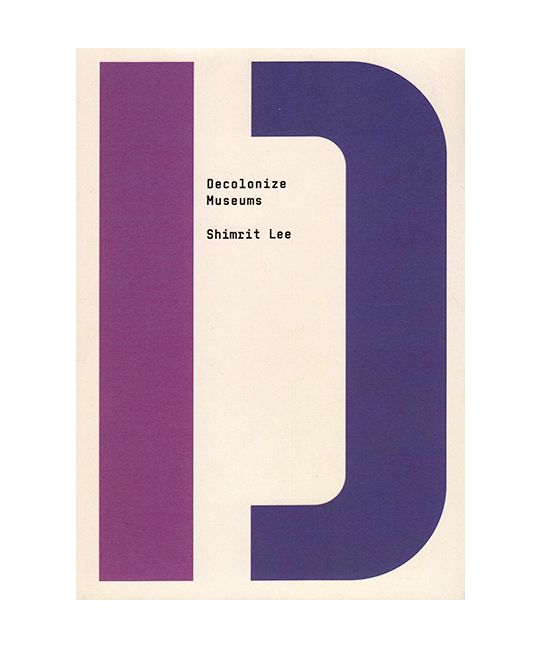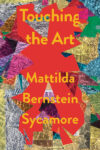
[OR Books; 2022]
Decolonize Museums by Shimrit Lee is one of the first offerings in the Decolonize That! series from OR Books, edited by Bhakti Shringarpure of Warscapes magazine. The subtitle for the series is “Handbooks for the Revolutionary Overthrow of Embedded Colonial Ideas.” Lee’s text is certainly a powerful guide through the colonial foundations that inform museum practices of collecting and commemoration, whose consequences are increasingly felt across the globe in protests and calls for repatriations.
Decolonize Museums begins with a preface from Shringarpure, who reminds us that “the violence that undergirds museums is not a vague colonial violence of cultural memory, or an erasure of heritage. It is a specifically settler colonial violence that is ongoing and underway.” This timely insistence is followed up with a necessary reflexivity:
Decolonize Museums illustrates the limitations of “decolonize” as a revolutionary frame. Decolonizing museums is certainly an excellent starting point because it means reckoning with barbaric histories, and the commodification of bodies and their objectified remains. It also means slowly moving towards saying NO to art and an art world that nourishes such institutions.
Shringarpure advocates for defunding, boycotting, and striking against the museum, concluding the preface with a note that matches Lee’s rigor: “This book did me in and it will most likely do the same for you. I’ll never set foot in a museum again. Perhaps, you will be moved to do the same.” While I visited several museums as I read this book, the museum as a site of crime and death became glaringly obvious.
Lee introduces the normalization of this violence with a brief discussion of the 1981 film Indiana Jones and the Raiders of the Lost Ark. The protagonist adventurer takes several cultural and sacred objects such as a golden idol from a temple in Peru and an ancient Hebrew tabernacle; his signature phrase is “That belongs in a museum!” Lee notes that he gives these items to the National Museum of Washington, D.C., “where the violence of imperial adventure becomes even further removed from view—absorbed into curated displays or placed into warehouses for study.” Such fictions of objectivity and neutrality are the crux of the definition of “museum” and persist in curatorial practice today, such as in “wall texts [that] often tell neutral, authoritative narratives of the objects displayed, but that passivity fails to reckon with the extractive nature of colonialism by which most of the Global South was robbed of culture, resources, and people in plain sight.” These unaddressed legacies have long-lasting effects, which Lee details in four chapters that focus on the collection, the gaze, the narrative, and the money, respectively.
In the first chapter, “Returning the Collection,” Lee focuses on repatriation, or the “return of stolen cultural materials to their countries of origin.” Taking a roving, international perspective, Lee details several calls for repatriation, notably the French President Emmanuel Macron’s pledge in 2017 that within five years, France would begin the return of African objects to Africa. Lee notes Macron’s progressive stance, situating it within a broader western European context: “Macron’s statement, like those of his contemporaries across the continent, can be read as a rather radical departure from the decades of denial, whitewashing, and even nostalgia that characterizes Europe’s relationship with its imperial history.” Though this bodes well, Lee follows the thread to 2019, when the renowned Benin treasures, which were robbed by French missionaries in 1892–1893, remained in France for legal reasons: “Under French law, national collections are protected with ‘inalienable and imprescriptible’ rights, prohibiting museums from permanently handing over accessioned objects.” While the National Assembly of France passed a bill to bypass the current restrictions to facilitate the return of the looted artifacts to Benin, Lee’s careful threads weave a bigger picture of the contradictions and bureaucracy that made this thieving possible, propped up by laws which uphold old colonial orders even today. But Macron’s actions instigated other European nations such as the Netherlands and Ireland to return looted collections; pledges by these countries have been crucial steps in the repatriation process.
While legal machinations and political bureaucracy in repatriation efforts may bog down any text, Lee writes with a remarkable clarity that stitches together several time periods and countries, constantly working towards clarifying the progress of repatriation efforts. She often uses questions to tie several contexts together, guiding the reader to make international links with ease. For example, to bring together the discussion on Macron with colonial histories, she asks:
How did vast amounts of African cultural heritage end up in Europe? The looting of cultural heritage began before the colonial period and continues after the independence of most colonized nations. But I begin this story with the Berlin Conference of 1884. It was here that European leaders set the stage for the so-called “scramble for Africa. . . . By setting up the continent as an amusement park for Europeans, the Conference opened the door for Africa’s cultural and natural heritage to be plundered and transferred to Europe.
Lee’s first-person positionality within the text is a subtle but authoritative guide that urges us to consider links to history which may not be immediately evident, and which fall outside the purview of “art history” as we know it; one of the aspects that truly makes this collection a “handbook” is its uncompromising engagement with history. By considering the conquest and partition of Africa, the links between colonization, collection, and repatriation become hard to unsee. This approach also prevents a foregrounding of explorer narratives, which often take precedence in museum histories of collection and accession.
Instead, Lee embraces the complexity of contradiction that characterizes colonization and its legalities. In a section subtitled “Legislating Theft,” she considers how colonial theft occurred outside of expeditions. Revisiting archaeological looting in Iraq, she notes that looting was carried out “through the legal oversight of the Antiquities Law of 1924,” which enabled Gertrude Bell, “a British adventurer, archaeologist, and mountaineer” to appoint herself as the intermediary between Iraq’s King Faisal and British officials. Lee includes a letter Bell wrote to her father, which reveals a worldview that justified the salvage and rescue efforts of archaeological spoils as a necessary reason for intervention. Lee reflects: “Bell’s letter shows that she saw deciding the fate of Iraq’s cultural heritage as her own unique responsibility. Yet ironically, Bell identifies herself as an Iraqi official, even as she decides to keep the Iraqi government in the dark concerning the value of the country’s artifacts.” In her analysis of these primary sources, Lee makes visible the erasures of culture through law, whose repercussions can still be felt today; she notes that the Iraqi public generally sees the museum “unfavourably as a government symbol.”
In the second chapter, “Subverting the Gaze,” Lee traces a genealogy of museums to show how “exhibitions and colonialism went hand in hand.” As the head of the US Smithsonian Institution from 1887 to 1896, George Browne Goode thought of world’s fairs as “laboratories for developing new techniques in installation and labeling. For instance, at Philadelphia’s 1876 Centennial Exhibition, he debuted prefabricated exhibition cases as well as printed labeling techniques for objects—both foundational to curatorial techniques used today.” These systems fostered a sense of the world as a spectacle to be displayed, controlled, and categorized (numerous exhibitions and expos comprised of raw materials and human beings shipped directly from the colonies). These typological methods created a gap between representation and reality, a paradigm shift in the nineteenth century, when “Europeans had come to view themselves as separate from the physical world, thus enabling them to observe and control it.”
During this moment, which preceded a crisis of representation, Lee also tells the heartbreaking story of sociologist W.E.B. DuBois, who curated an exhibition on African American life and culture for the 1900 Exposition Universelle in Paris. He attempted to make room for Black representation in a European world’s fair by creating an infographic showing the percentage of illiterate African Americans from 1860–1900, but “he became disenchanted with the scientific approach he used at the Paris Exposition to convince the world of the injustice experienced by African Americans. As he wrote, ‘one could not be a calm, cool, and detached scientist while Negroes were lynched, murdered, and starved.’” Lee also touches on the story of Ota Benga, an African exhibited at the St. Louis Fair and who was made to be a permanent feature at an exhibition in the American Museum of Natural History. There he hurled a chair at philanthropist Florence Guggenheim and was transferred to the Bronx Zoo, where he took his own life. Lee concludes with a powerful statement that introduces the final two chapters: “A decolonial ethos requires a radical memorialization of the dehumanization at the center of histories of museums and their predecessors. It also demands a more expansive, liberatory form of truth-telling—one that has the potential to transform the museum into a site of healing.” Lee shows that healing is often an iterative process. She outlines several ways museums undertake healing, from reflexive interventions to welcoming the public to build and recover community.
While the first two chapters set the groundwork for the colonial histories of museums and their long-lasting legacies, the final two address the ways in which institutions have attempted to “decolonize.” Lee draws on the work of writer Mary Louise Pratt and anthropologist James Clifford, who advocated for the museum as a “contact zone,” which he defines as a “permeable space for transcultural encounters.” These and other views heralded a “new museology” in the nineties which created major shifts, such as the focus on concepts instead of objects, the shift from conservation to active curation, and the interactive role of visitors. These changes were the beginnings of “decolonial exhibition-production,” which contributed to multivocal exhibits and a transformation of the gallery space to a space of encounter.
Thankfully, Lee returns to contradictions. When curators shift exhibitions from “displays of objects to displays of displays,” she notes that these reflexive interventions sometimes cloak exhibits in irony, “thus granting curators ‘subcultural capital’ while shielding them from difficult questions.” Lee extends a discussion of these contradictions to corporate art sponsorship and several artists’ attempts to intervene, such as Indigenous artist Rebecca Belmore’s performance titled Artifact #671B. In 1988, in Calgary, Alberta, three days before the Shell-sponsored show The Spirit Sings (which coincided with the winter Olympics), Belmore “sat inside a museum case in below freezing weather, her body tagged like an artifact with Shell’s corporate logo.” As a result, the second presentation of The Spirit Sings took place alongside a conference hosted by the Canadian Museums Association and the Assembly of First Nations where several concerns, such as Indigenous inclusion in cultural institutions and resource extraction, were discussed. While public funding continues to be slashed and institutions turn to private and corporate funders for capital, Lee reminds us that the need to “decolonize” has ethical implications that extend far into the future.
Decolonize Museums is a book with its pulse on our time, but it also reads ahead of its time because Lee makes the painstaking effort to detail colonial nuances and contradictions across centuries, gathering entertaining pop-cultural contexts alongside more somber historical research to evidence the impact of these legacies. Lee’s generosity enlivens her closing note: “It is my expectation—and hope—that this book will grow increasingly outdated. The alarm bells of public scrutiny ring louder each day, inspiring new developments in the history of museum decolonization.” But her generosity also shines in the approach to the collection. There could have been many ways to organize such an expansive book: from chronology to region or artistic medium. Her method of a frank essayistic tone and accessible but in-depth research, which interrogates the foundations of museum and curatorial principles, makes Decolonize Museums an abundant read—it should be stocked in every museum gift shop worldwide.
Shazia Hafiz Ramji’s writing is forthcoming in Momus and has appeared in the 2022 Montreal International Poetry Prize anthology. She is the author of Port of Being, a book of poems drawn from surveillance maps, field recordings, overheard conversations, and the performance art of Vito Acconci to reclaim her experience of being stalked. She lives in western Canada and London, where she teaches creative writing and is at work on a novel.
This post may contain affiliate links.







